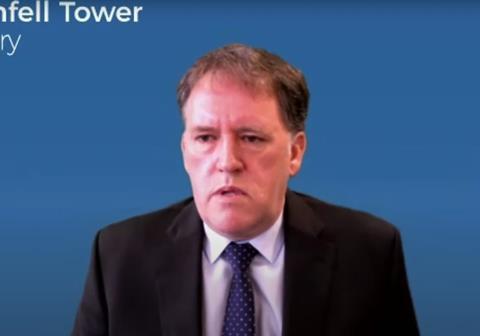BREŌĆÖs Phil Clark tells inquiry testing room could have ŌĆś10 people in on any given dayŌĆÖ
A senior testing technician has blamed a string of apparent errors he made when testing insulation destined for Grenfell Tower on the testing hall being too busy, the inquiry has heard.
Former ║├╔½Ž╚╔·TV Research Establishment (BRE) burn hall manager Phil Clark told WednesdayŌĆÖs hearing: ŌĆ£What you need to understand is that the burn hall was a very busy place. We could have 10 people in on any given day.ŌĆØ
The inquiry heard yesterday how Clark had apparently not noticed that a May 2014 fire test of a wall construction that contained manufacturer CelotexŌĆÖs RS5000 insulation had cement panels of different thicknesses.
Celotex had replaced 8mm cement fibre panels used in a failed test in February of that year with 12mm cement panels, which it hoped would better resist flames. The test passed.
However, in two places on the test rig the panels were 8mm thick and covered 6mm boards of fire resistant magnesium oxide, a material which was neither logged in official BRE documents nor included in the insulationŌĆÖs marketing material.
But ClarkŌĆÖs signature has been found on a delivery note for the 8mm panels, despite his claim that he thought all of the boards were of the same thickness.

Asked by counsel to the inquiry Richard Millett QC how this ŌĆ£lapseŌĆØ had come about, Clark replied that the burn hall was ŌĆ£very fluid and dynamic,ŌĆØ adding: ŌĆ£We could have four or five deliveries from drivers directly to the hall, we could have stuff coming in from goods-in, we could have people testing, preparing, so it was a very busy place, and it wasnŌĆÖt the position that we were there every single minute checking everything that the client did minute to minute.ŌĆØ
On Tuesday, Clark denied being aware of the magnesium boards which were hidden beneath the 8mm cement panels, telling the hearing: ŌĆ£I would have reported it. And had I known it, I would have stopped the test.ŌĆØ
But yesterday the inquiry was shown video footage filmed from ClarkŌĆÖs helmet camera in the burn hall during the May 2014 test in which he told former Celotex assistant product manager Jonathan Roper: ŌĆ£See how that flame seems to have ceased now that the board is there because youŌĆÖre losing a lot of the energy from behind it.
ŌĆ£The other thing as well is itŌĆÖs something thatŌĆÖs quite big behind the board [because] it extends the flame vents.ŌĆØ
Asked by inquiry chairman Martin Moore-Bick why had said ŌĆ£now that the board is there,ŌĆØ Clark said: ŌĆ£I donŌĆÖt know, itŌĆÖs just speaking - a general conversation.ŌĆØ
And he said when he had talked about something behind the board he had been referring to flames.
In another exchange captured in the footage, Clark had said ŌĆ£Sometimes changing two things at a time doesnŌĆÖt always give you an advantage.ŌĆØ
Millett suggested this had referred to the two changes in the test - the magnesium boards and the thicker 12mm cement panels.
But Clark denied he knew two things had changed in the construction of the wall being tested and said he was only referring to ŌĆ£the scientific principle that if you change two key items, two key variables, you donŌĆÖt know which one has had a positive effect.ŌĆØ
Clark was later accused of giving false evidence to the inquiry after claiming on Tuesday that he had been given ŌĆ£no accessŌĆØ to files on the BRE systems when preparing his witness statement.
He had told TuesdayŌĆÖs hearing: ŌĆ£one of the things you need to be aware of is that post the fire at the tower, all of the systems that - both paper and electronic, were locked down at BRE, so I had no access to any files on any of the systems. So anything that I was given, I was reliant on BRE to provide me.ŌĆØ
But it was revealed that the BREŌĆÖs lawyers from Fieldfisher had sent a letter to the inquiry earlier in the day that stated that Clark had in fact been given full access to BRE documents for a three days period in July 2019 while he was preparing his witness statement.
Millett asked if Clark had attended the BREŌĆÖs site. Clark replied: ŌĆ£I did for about one or two days, maybe.ŌĆØ
Millett said: ŌĆ£[The BREŌĆÖs lawyers] say it was a three-day period.ŌĆØ
Clark replied: ŌĆ£Yes, thatŌĆÖs probably right, yes.ŌĆØ
Millett then asked: ŌĆ£When you told us yesterday in your evidence that you were reliant on what was sent to you, you were issued a packet of stuff , material was disclosed by the Inquiry, and you had no access to files after the fire on any of the systems, thatŌĆÖs not true, is it?ŌĆØ
Clark replied: ŌĆ£Yes, no, IŌĆÖd neglected to - I forgot that I - I understood that I went down there, but what I meant was I had - because I was only there - I could only review a certain amount of stuff.ŌĆØ
He added: ŌĆ£I just forgot IŌĆÖd gone there. IŌĆÖve never been in this situation. I donŌĆÖt know whatŌĆÖs relevant.ŌĆØ
The first phase of the inquiry into the June 2017 fire, which killed 72 people, found that the insulation included in the buildingŌĆÖs cladding system ŌĆØmore likely than notŌĆØ contributed to the spread of flames up the side of the tower.
The inquiry continues.



























